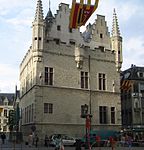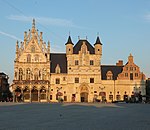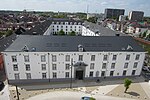St. Rumbold's Cathedral

St. Rumbold's Cathedral (Dutch: Sint-Romboutskathedraal) is the Belgian metropolitan archiepiscopal cathedral in Mechelen, dedicated to Saint Rumbold, Christian missionary and martyr who had founded an abbey nearby. His remains are rumoured to be buried inside the cathedral. State-of-the-art examination of the relics honoured as Saint Rumbold's and kept in a shrine in the retro-choir, showed a life span of about 40 years and a death date between 580 and 655, while tradition had claimed 775 AD.In 1999, the tower of the cathedral was inscribed on the UNESCO World Heritage List as part of the Belfries of Belgium and France site, in recognition of its architecture and its importance in civic duties such as a watchtower.
Excerpt from the Wikipedia article St. Rumbold's Cathedral (License: CC BY-SA 3.0, Authors, Images).St. Rumbold's Cathedral
Grote Markt, Mechelen
Geographical coordinates (GPS) Address Nearby Places Show on map
Geographical coordinates (GPS)
| Latitude | Longitude |
|---|---|
| N 51.028888888889 ° | E 4.4783333333333 ° |
Address
Sint-Romboutstoren
Grote Markt
2800 Mechelen (Mechelen)
Antwerp, Belgium
Open on Google Maps









